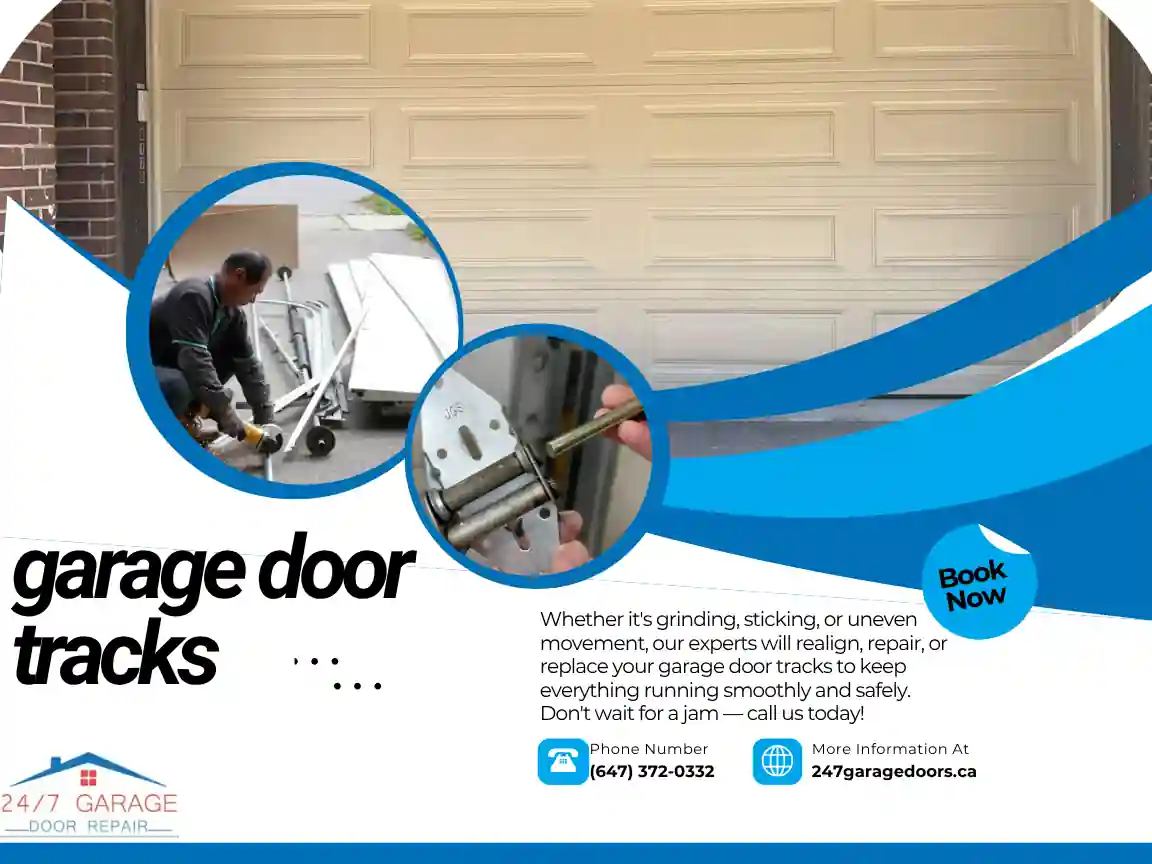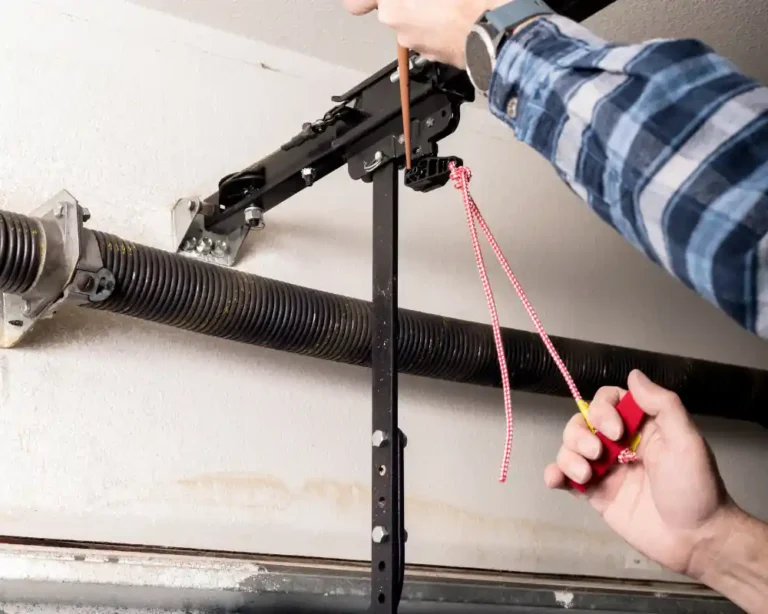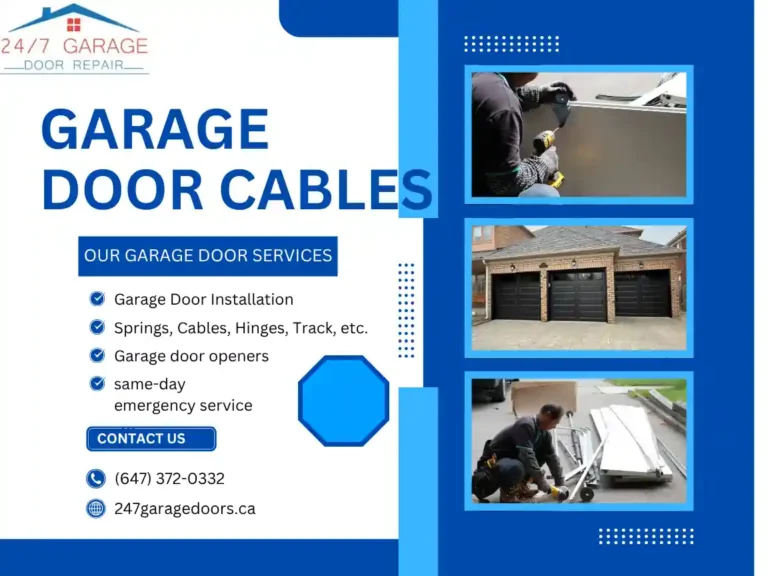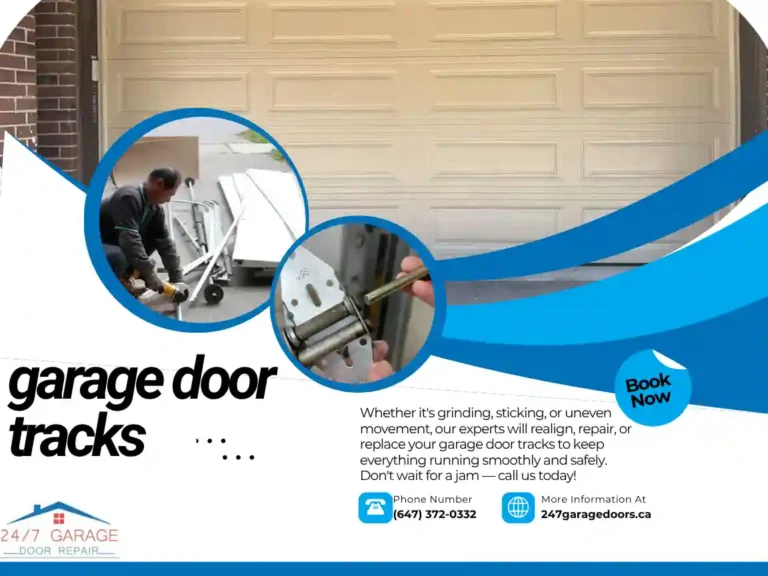The Unsung Heroes: Navigating the World of Garage Door Tracks
You probably don’t think much about them, but those unassuming metal channels running along the sides and overhead in your garage are vital. We’re talking about garage door tracks. These precise pathways guide your garage door’s rollers, ensuring it moves smoothly and safely up and down, day in and day out. When your garage door starts to bind, squeak, or, worse yet, gets stuck or comes off its hinges, there’s a very good chance the culprit lies within your tracks.
At 24/7 Garage Doors, we understand that well-maintained garage door tracks are the backbone of a reliable garage door system. In this extensive guide, we’ll delve into the different types of tracks, common problems they face, the importance of professional maintenance and repair, and why addressing track issues promptly is crucial for your garage door’s longevity and your family’s safety.
What Are Garage Door Tracks and Why Are They So Important?
At their core, garage door tracks are the metal rails that provide the structural framework for your garage door’s movement. Your door’s rollers fit snugly inside these tracks, allowing the door to glide effortlessly between the open and closed positions.
The track system typically consists of:
- Vertical Tracks: Mounted on each side of the door opening, running from the floor up.
- Horizontal Tracks: Extending backward from the top of the vertical tracks, running parallel to the garage ceiling.
- Curved Tracks: Connecting the vertical and horizontal sections, allowing the door to transition smoothly as it opens or closes.
Without properly installed and maintained garage door tracks, the entire system would fail. They bear the weight of the door as it transitions, ensure proper alignment, and work in conjunction with the springs and opener to facilitate seamless operation.


Types and Materials of Garage Door Tracks: Not All Are Created Equal
While the basic function remains the same, garage door tracks come in various types and thicknesses to accommodate different door weights and garage configurations.
Common Track Widths:
- 2-inch Tracks: Most commonly used for residential garage doors. They are designed for standard door weights and sizes.
- 3-inch Tracks: Used for heavier residential doors, or more commonly for commercial and industrial garage doors that require a sturdier guide system.
Track Thickness (Gauge): Tracks are made from galvanized steel to resist corrosion. Their thickness, or gauge, indicates their strength. Thicker gauges (lower numbers) are stronger.
- Residential: Typically range from 16-gauge (.055 inches) to 14-gauge (.062 inches). Heavier wood doors might use 12-gauge (.075 inches).
- Commercial/Industrial: Often use 12-gauge or even 10-gauge (.109 inches) for very heavy doors.
Track Lift Types: The way a garage door opens and its track configuration depends on the available headroom in your garage.
- Standard Lift: Most common residential setup. The door goes up vertically a short distance, then curves and travels horizontally overhead.
- Low Headroom: Designed for garages with limited space above the door opening. These tracks feature a special dual-track system or a tight radius curve to allow the door to open in a smaller vertical space.
- High Lift: Used when there’s significant headroom. The vertical tracks are extended, allowing the door to travel higher up the wall before curving to the horizontal position. This is ideal for maximizing overhead storage space.
- Vertical Lift: Primarily for commercial applications with very high ceilings. The door travels straight up vertically until it’s entirely above the opening, with no horizontal tracks.
Understanding the type of garage door tracks installed in your home is important, as it influences repair and replacement options. You can read more about the various types of garage door tracks to see how they differ.
Common Problems with Garage Door Tracks: Signs of Trouble
Even with robust construction, garage door tracks can develop problems over time. Recognizing these signs early can prevent more significant, costly damage and ensure safety.
Here are the most common issues:
- Misalignment: This is perhaps the most frequent problem. Tracks can become misaligned due to loose mounting bolts, impacts (e.g., hitting the door with a car 🚗), shifting foundations, or even just general wear and tear. When tracks are misaligned, the door will not move smoothly.
- Bent or Damaged Tracks: Physical impact, forcing a stuck door, or even structural shifts can cause tracks to bend, dent, or crimp. A bent track will create friction, causing the door to bind or stick.
- Loose Mounting Hardware: The bolts and fasteners that secure the tracks to the garage walls can loosen over time due to vibrations from daily operation. Loose tracks will move, causing misalignment and instability.
- Obstructions or Debris: Dirt, dust, small pebbles, leaves, or even solidified grease can accumulate inside the tracks, creating blockages that impede roller movement.
- Worn Rollers: While not a track problem directly, worn or damaged rollers (flat spots, chipped wheels) can cause the door to drag, squeak, and eventually contribute to the door coming off track due to increased friction and improper guidance.
- Rust and Corrosion: Especially in humid environments or if exposed to road salts, tracks can rust. Rust creates a rough surface that increases friction and can weaken the metal.
Red Flags: Signs Your Garage Door Tracks Need Attention
Your garage door will often tell you it’s having trouble with its tracks before a complete breakdown occurs. Pay attention to these warning signs:
- Unusual Noises: Scraping, grinding, squealing, or loud banging sounds during operation are strong indicators of track issues, often caused by misalignment or debris. 🔊
- Jerky or Uneven Movement: If the door shudders, struggles, or appears to move unevenly (one side higher than the other) as it opens or closes, your tracks are likely out of alignment or damaged.
- Door Gets Stuck or Binds: If the door stops midway, struggles to close completely, or appears to “catch” on something, friction within the tracks is probably the cause.
- Visible Gaps Between Rollers and Tracks: Your rollers should sit snugly within the tracks. If you see them wiggling excessively or notice visible gaps, the tracks might be spreading apart or misaligned.
- Door Looks Crooked When Closed: A properly aligned door should sit flush and level with the ground. If it appears tilted or leaves uneven gaps along the bottom or sides, track misalignment is a likely cause.
- Rollers Coming Off Track: This is a critical safety hazard and demands immediate attention. If one or more rollers jump out of the track, the door can become dangerously unstable or even collapse.
If you observe any of these symptoms, it’s crucial to act promptly. Addressing the problem early can prevent minor issues from escalating into major, costly repairs or dangerous situations.
DIY vs. Professional Garage Door Track Repair Services
When you notice issues with your garage door tracks, your first thought might be to tackle it yourself. While minor issues like cleaning tracks or tightening clearly loose bolts can be DIY, anything involving alignment, bent tracks, or a door that’s come off track should be handled by a professional.
| DIY Task (Minor Issues) | Professional Required (Major/Complex Issues) |
| Cleaning Tracks | Track Alignment |
| Tightening Visible Bolts | Bent or Damaged Track Repair/Replacement |
| Lubricating Rollers | Door Off Track Situations |
| Checking Safety Sensors | Spring & Cable Related Track Issues |
| New Track Installation |
Why Professional Garage Door Track Repair Services are Essential:
- Safety: Garage doors are heavy, and the springs and cables are under extreme tension. Attempting to force a misaligned door or work on tracks when the door is under tension can lead to severe injury. Professionals have the tools and expertise to work safely.
- Precision and Expertise: Correct garage door track alignment requires precision. Even a slight misalignment can cause ongoing problems. Professionals use levels and specialized techniques to ensure tracks are perfectly plumb, parallel, and properly spaced.
- Comprehensive Diagnosis: A professional will not just fix the visible problem but will assess the entire system. A track issue might be a symptom of a deeper problem with worn rollers, damaged springs, or an imbalanced door.
- Proper Tools and Parts: Technicians have access to the right tools for bending, adjusting, or replacing tracks, as well as a range of quality replacement parts.
- Warranty Protection: Attempting complex DIY repairs can void your garage door’s warranty. Professional repair ensures your warranty remains intact.
For any situation beyond basic cleaning or tightening, especially if your garage door came off track, it’s always safest and most cost-effective in the long run to call for expert garage door track repair services.
The Cost of Garage Door Track Repair: What to Expect
The cost of garage door track repair can vary significantly based on the severity and nature of the problem:
- Minor Adjustments/Cleaning: If it’s just a simple realignment or cleaning of debris, the cost might be on the lower end, sometimes as part of a general tune-up.
- Bent Track Straightening: If tracks are mildly bent, a technician might be able to straighten them, which is less costly than replacement.
- Track Replacement: If tracks are severely bent, rusted, or damaged beyond repair, replacement is necessary. This involves the cost of new tracks (around $100-$300 per set, depending on type/gauge) plus labor.
- Door Off Track Repair: This can be more complex, as it often involves re-setting the door, inspecting and possibly replacing rollers, and realigning tracks. Costs for this can vary widely but typically range from $150 to $400 or more, depending on the extent of damage to rollers or other components.
- Comprehensive System Repair: Sometimes, track issues are a symptom of other problems, like worn rollers or faulty springs. The overall cost would then include these additional repairs.
While a minor repair might seem like a small expense, remember that neglecting track issues can lead to much larger problems, including damage to the garage door panels themselves, the opener, or even personal injury. Investing in professional garage door track repair services is investing in the safety and longevity of your entire system.
Preventative Maintenance for Your Garage Door Tracks
Regular maintenance is key to preventing problems with your garage door tracks and ensuring your garage door operates smoothly for years to come.
- Visual Inspection (Monthly):
- Look for any bends, dents, or crimps in the tracks.
- Check for loose mounting bolts or fasteners holding the tracks to the wall.
- Ensure the rollers are sitting securely within the tracks and aren’t wobbly or chipped.
- Look for rust or corrosion on the tracks.
- Clean the Tracks (Every 3-6 Months):
- Use a damp cloth to wipe down the inside of the tracks. Remove any accumulated dirt, dust, grease, or debris. A vacuum cleaner can help with stubborn grime.
- Do NOT apply grease or heavy lubricants inside the tracks, as this can attract dirt and grime, making matters worse. The rollers are designed to glide on the clean metal.
- Lubricate Rollers (Annually):
- While not directly for the tracks, lubricating the garage door rollers (especially their bearings and stems, if metal) will significantly reduce friction and ensure they glide smoothly within the tracks. Use a silicone-based garage door lubricant.
- Professional Tune-Up (Annually):
- Schedule a yearly professional inspection and tune-up. A technician will perform a thorough assessment of your entire garage door system, including precise garage door track alignment, spring balance checks, cable inspection, and lubrication of all moving parts. This proactive approach catches minor issues before they become major problems. For comprehensive DIY tips and when to call a pro, this garage door maintenance checklist offers good guidance.
Your Trusted Partner for Garage Door Track Repair and Service
When your garage door tracks are causing problems, you need a reliable and experienced team to provide a solution. At 24/7 Garage Doors, we specialize in comprehensive garage door services, including expert garage door track repair services.
We understand the intricacies of all types of garage door systems and are equipped to handle everything from minor realignments to extensive track replacements. Our certified technicians prioritize safety, efficiency, and lasting results. We’ll diagnose the root cause of your track issues, provide transparent pricing, and execute the repair with precision, ensuring your garage door operates as good as new.
Don’t let a crooked, noisy, or stuck garage door disrupt your day or compromise your home’s security. Prompt attention to garage door tracks can save you time, money, and headaches in the long run.
For expert garage door track repair, maintenance, or any other garage door service, please give 24/7 Garage Doors a call for further information or to book with us today! We’re here to ensure your garage door continues to glide smoothly and reliably. 📞










